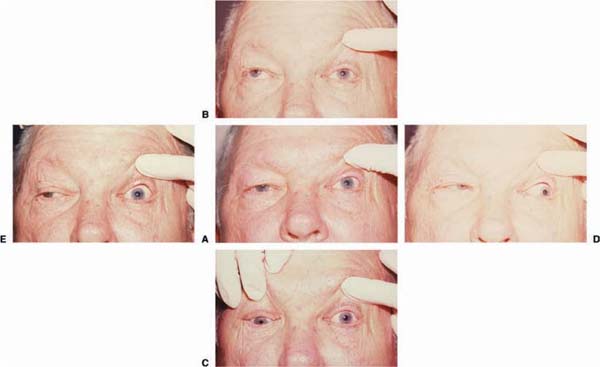Chapter 30 Third (oculomotor; III) nerve palsies are important to diagnose urgently because they may be harbingers of life-threatening disease, particularly aneurysms of the junction of the posterior communicating and carotid arteries. A patient with third nerve palsy should be evaluated immediately, unless the initially consulted physician is convinced that the palsy is complete and pupil-sparing. Patients with third nerve palsies present with binocular diplopia, unless the vision in one eye is extremely poor, there is depressed mental status, or most commonly, the ipsilateral eye is occluded by a ptotic lid. The two images are usually diagonally separated, although horizontal and vertical diplopia are also seen. In patients without diplopia or in infants, family members or friends are alerted to the condition by the ocular misalignment. Ptosis is commonly noted by patients when the branches of the third nerve, which supply the levator palpebrae, are affected. Patients and/or family members may also have noted anisocoria, with a dilated ipsilateral pupil. Patients with third nerve palsies may complain of pain, regardless of etiology. The pain may range from mild to severe, but its degree is of little help to the clinician in differentiating etiologies. Although compressive third nerve palsies from aneurysms are frequently painful and microvascular third nerve palsies are often not, a microvascular palsy can be excruciating and an aneurysmal palsy painless. In a complete third nerve palsy there is total absence of adduction, elevation and depression of the ipsilateral eye. On attempted downgaze, there should be some intorsional movement as a result of preserved fourth nerve function. As a result of this unopposed fourth nerve function, as well as unopposed sixth nerve function, the affected eye is hypotropic and exotropic (i.e., deviated downward and laterally). In third nerve palsies that are incomplete, there may be only partial limitation of adduction, elevation, and depression. Complete third nerve palsy produces complete ipsilateral ptosis. The ptosis may be incomplete in partial third nerve palsies. Ipsilateral pupillary dilation may also be seen in third nerve palsy. Such a finding is an ominous sign because it may indicate the presence of a compressive lesion, either a tumor or an aneurysm at the junction of the posterior communicating artery and the internal carotid artery. Although microvascular third nerve palsies usually do not cause pupillary dilation, very mild anisocoria (up to 1 mm) can occasionally be seen.1 To be safe, any pupillary dilation out of proportion to the amount of extraocular muscle involvement should be considered compressive in origin until proven otherwise. FIGURE 30–1 A E: Eye movements and clinical appearance in acute right oculomotor (third cranial) nerve palsy. In primary position (A), there is ptosis and mild exodeviation of the right eye. In attempted up (B), down (C), and left (D) gaze, the right eye shows marked limitation of range compared with the left. In attempted right gaze (E) (left photograph) the right eye moves fully, indicating normal abducens (VI cranial) nerve function. The right pupil is minimally dilated. Regeneration of third nerve fibers after injury may be faulty, with fibers destined for one muscle ending up at another muscle. This is termed aberrant regeneration. Typical signs of aberrant regeneration are: • Pupillary miosis with upgaze, downgaze, or adduction • Lid retraction with downgaze (pseudo von Graefe sign) or with adduction • Adduction on elevation or depression Aberrant regeneration can follow traumatic or compressive injuries of the third cranial nerve, but almost never microvascular disease. In the absence of a known previous traumatic or compressive third nerve palsy, the presence of aberrant regeneration mandates a search for a slow-growing mass lesion, often in the cavernous sinus. Other causes of aberrant regeneration are congenital third nerve palsies, syphilis, and basilar meningitis.
THIRD NERVE PALSIES
URGENCY OF EVALUATION
DIAGNOSIS
SYMPTOMS
Diplopia
Ptosis
Anisocoria
Pain
SIGNS
Ophthalmoplegia (Fig. 30–1)
Ptosis
Ipsilateral Pupillary Dilation
Aberrant Regeneration
Divisional Third Nerve Palsy
Stay updated, free articles. Join our Telegram channel

Full access? Get Clinical Tree



